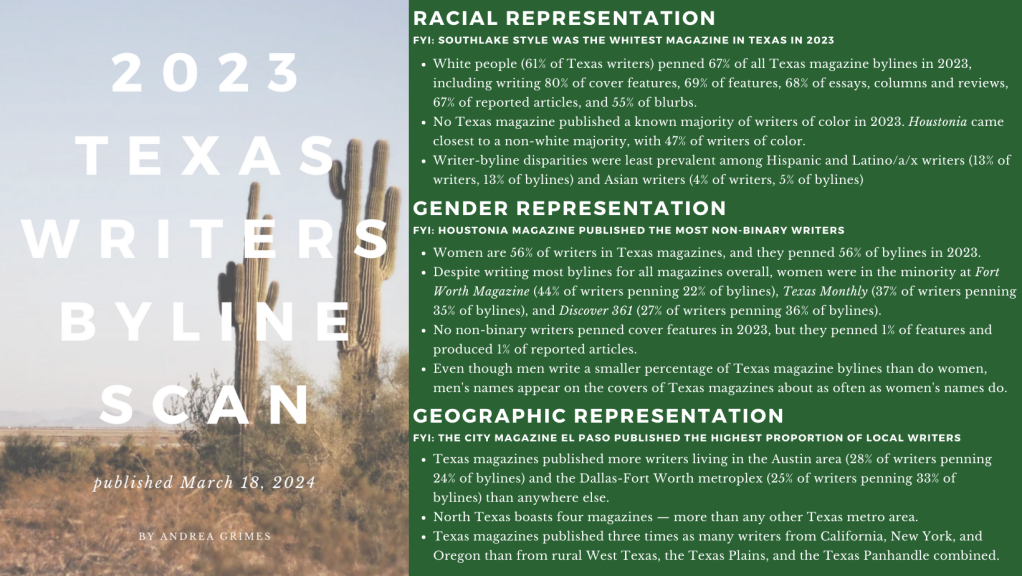My latest survey of nearly 500 writers and over 2,200 bylines shines a light on who is writing stories for and about Texas and Texans.

The 2023 Texas Writers Byline Scan — the third annual — is a survey of 491 writers who published 2,245 bylines in Texas print publications (monthly, bimonthly, and quarterly) in the year 2023. The project examines who wrote for Texas magazines over the course of the previous year, tracking writers’ identities along the axes of race, gender, and location.
For the third annual scan, past-year readers will notice several changes and updates. This year, I looked at 16 print publications, up from 15 in 2022 and 11 in 2021: three statewide-coverage magazines, all members of Texas’ City and Regional Magazines Association chapter, and magazines covering East Texas and El Paso.
The biggest difference between past scans and this report is improved accuracy and over-time results, and a broader geographic range of magazines surveyed. There are fewer “unknowns” across all categories in ‘23, and because the ‘23 scan data is more complete than the previous year’s, the ‘23 report includes not only side-by-side comparisons of magazines across demographics for 2023, but also year-over-year comparisons of Texas magazine demographics since 2021.
If you’re ready to dive into the 2023 Texas Writers Byline Scan, download it here.
This is an independent, one-woman project that began in 2021. In future years, I hope to apply for grant funding to continue this work, but as of 2023, it continues to be funded and executed solely by me. None other such report exists; while some Texas magazines track demographics internally, none release data to the public and few share information directly with staff and freelancers.
I hope to enable Texas journalists to have a better, data-driven understanding of our work, even and especially as it becomes an increasingly tenuous career choice. I hope the byline scan offers a level-setting mechanism by which interested parties can track progress, stasis, or regression.
Please note: This scan is only an annual snapshot. It is not an analysis of the working conditions at Texas magazines or a statement about the intentions or biases of their staff, writers, editors or decision-makers. But we can’t talk about where Texas magazine journalism could go in the future without an idea of where we are today.
And here we are.
Here’s the big picture across all Texas magazines.
It was a rough year for Texas magazines. San Antonio Magazine paused print publication in late 2023, and along with Austin Monthly has been sold to new ownership at Hearst. Their longtime editors-in-chief now have new positions elsewhere. Houstonia magazine took on a new editor halfway through 2023 after an interim period without an editor-in-chief, and The City Magazine El Paso‘s editor-in-chief retired in 2023. The Texas Observer very nearly shuttered in 2023, and cut two staffers and its editor-in-chief in early 2024.
But I’ll keep analyzing Texas magazines for as long as somebody, somewhere keeps publishing them. This year, I scanned more magazines than ever:
- Texas Highways (monthly, statewide)
- Texas Monthly (monthly, statewide)
- The Texas Observer (bimonthly, statewide)
- 360 West (monthly, Fort Worth)
- Austin Monthly (bimonthly, Austin)
- The Bend Magazine (monthly, Corpus Christi)
- The City Magazine El Paso (monthly, El Paso)
- D Magazine (monthly, Dallas)
- Discover 361 (quarterly, Victoria)
- Etcetera (quarterly, Kilgore)
- ETX View (bimonthly, East Texas)
- Fort Worth Magazine (monthly, Fort Worth)
- Harrison Magazine (quarterly, Harrison County)
- Houstonia Magazine (quarterly, Houston)
- San Antonio Magazine (bimonthly, San Antonio)
- Southlake Style (monthly, Southlake)
This year, I was able to track writers’ tenure on the byline scan, looking at who has appeared in past years’ scans and how frequently. I found that writers with the most longevity on the scan — i.e., those who wrote for Texas magazines in 2021, 2022, and 2023 — were more likely to be white, more likely to be male, and more likely to live in Austin.
Just as they were in 2021 and 2022, white writers are once again disproportionately overrepresented in Texas magazines compared to the state’s population overall. They write more of everything — especially prestige bylines like cover stories and features — than do writers of color.
In terms of gender, women make up 56% of Texas writers and pen 56% of Texas bylines, and non-binary writers continue to make up a very small proportion of Texas writers, at 2% of non-binary writers penning less than 1% of Texas magazine bylines. This was the first year since the TWBS launched in 2021 that the report identified an out transgender writer with bylines in a Texas magazine.
Writers in Dallas-Fort Worth and Austin were published more often than writers from San Antonio, Houston, and El Paso. Writers from California, New York, and Oregon were published three times as often as writers from rural West Texas, the Texas Plains, and the Texas Panhandle combined.
Looking at intersectional racial and gender identities: Men of color and non-binary writers of color continue to be the least frequently represented among Texas magazine writers and Texas magazine bylines. That isn’t to say that women of color write a great deal for Texas magazines — they made up just 17% of writers at Texas magazines in 2023 and penned 15% of bylines. Men of color were 10% of Texas magazine writers in 2023, and penned 10% of bylines.
So let’s tease out some magazine-level findings:
- Southlake Style — which “creates and nurtures connections within the community it covers” — consistently ranks among the whitest magazines in Texas, and in 2023 it was the very whitest, with 96% of its bylines penned by white writers. Its publisher has, in the past, asked me not to contact him about the byline scan.
- Austin Monthly and Fort Worth Magazine also continue to publish an outsized-among-the-outsized proportion — over 80% — of bylines by white writers.
- Magazines drawing from the least-diverse pool of writers were Southlake Style, Fort Worth Magazine, Austin Monthly, Etcetera/ETX View/Harrison, Discover 361, and San Antonio Magazine, with writers represented from three or fewer racial identity groups.
- Non-binary writers were most often represented in Houstonia and the Texas Observer. Of the 16 magazines I surveyed, 10 published no bylines by known non-binary writers.
- Texas Monthly showed a notable drop in bylines from women writers in 2023, with just 37% of women writers penning 35% of the magazine’s bylines — down from 46% of women writers penning 53% of its bylines in 2022.
- Men were most often represented in Austin Monthly, Discover 361, Texas Monthly, Southlake Style, and Fort Worth Magazine, with those publications running between 58% and 77% of bylines by men.
- Fort Worth Magazine published an article by a dog, which was hard to classify! Thanks for spicing up the byline scan, Luke.
- The Texas Observer was the least Austin-centric of Texas’ statewide-coverage magazines, publishing just 49% of bylines by Austin writers. In contrast, Texas Monthly published 65% of bylines by Austin writers, and Texas Highways, the “official travel magazine of Texas,” published 60% of bylines by Austin writers.
- The City Magazine El Paso published more local writers than any other publication, running 98% of bylines by El Paso writers.
How about y’all just go read this thing?
Comparing data over three years of the TWBS showed that there isn’t a ton of year-to-year change among demographic representation in Texas magazines. White writers consistently write around 67% of Texas magazine bylines, and the representation of women in Texas magazines has declined over the years: from 64% in 2021 to 61% in 2022, and 56% in 2023. It’s less surprising that geographic representation stays about the same year-to-year, with writers in Dallas-Fort Worth and Austin consistently penning about 50% of all Texas bylines.
Of course the TWBS is not (and couldn’t possibly) be a direct agent for improving diversity in Texas magazines — that has to come from editors, publishers, and magazine owners themselves — but I hope that by setting an annual baseline for Texas magazine representation, magazine stakeholders and decision-makers can be encouraged to improve the diversity of racial, gender, and geographic representation in their publications’ pages.
Please share the scan with your fellow media nerds, DEI enthusiasts, and change-resistant magazine editors.
Thanks for reading Home with the Armadillo! To get the latest posts in your inbox, subscribe below. And if you like what you read, consider dropping a few bucks in my tip jar.





Leave a comment